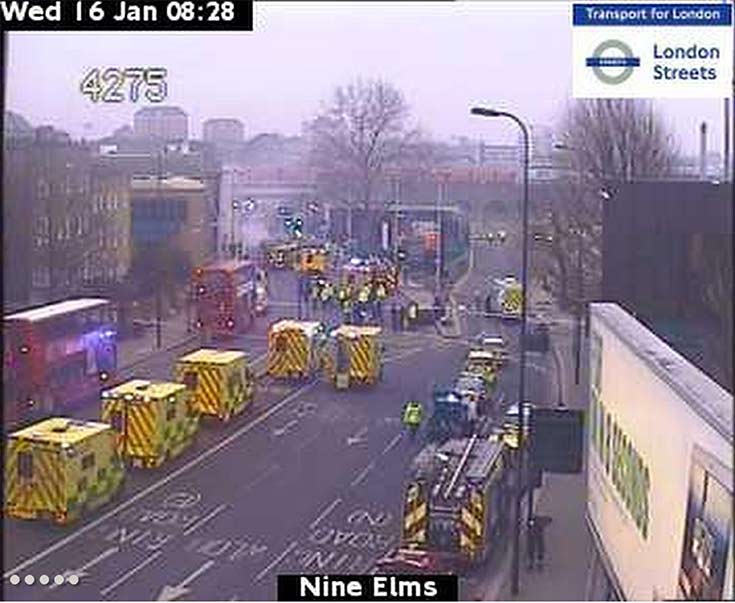Revised definition of UK 'Major Incident'
Editorial Advisory Panel Member and Security Correspondent Roger Gomm reports on how the Cabinet office has revised its definition of what constitutes a Major Incident, amid ongoing concern over the diversity and inconsistency of terms used by different responders to describe different incident types and triggers.
A revised definition for the term ‘Major Incident’ (MI) was put out for consultation through May and June 2016 by the Cabinet Office after concerns were raised about the general definition contained in the Joint Emergency Service Interoperability Programme (JESIP). A large number of responses were received, which informed a further revision of the definition and associated notes. It also raised a number of issues to be addressed in the up-coming revision of Emergency Response and Recovery (ER&R).

An image of a helicopter crash in Vauxhall, London, taken from a Transport for London traffic camera in 2013. The helicopter struck a crane on a building under construction (Equinox/Rex/Shutterstock)
The new definition reads as follows: An event or situation, with a range of serious consequences, which requires special arrangements to be implemented by one or more emergency responder agencies.
The following notes were issued with the definition by the Cabinet Office:
-
a) ‘Emergency responder agencies’ describes all Category one and two responders as defined in the Civil Contingencies Act (2004) and associated guidance;
-
b) A major incident is beyond the scope of business-as-usual operations, and is likely to involve serious harm, damage, disruption or risk to human life or welfare, essential services, the environment or national security;
-
c) A major incident may involve a single-agency response, although it is more likely to require a multi-agency response, which may be in the form of multi-agency support to a lead responder;
-
d) The severity of consequences associated with a major incident are likely to constrain or complicate the ability of responders to resource and manage the incident, although a major incident is unlikely to affect all responders equally; and
-
e) The decision to declare a major incident will always be a judgment made in a specific local and operational context, and there are no precise and universal thresholds or triggers. Where LRFs and responders have explored these criteria in the local context and ahead of time, decision makers will be better informed and more confident in making that judgment.
The Cabinet Office's observations on the responses was: “While a consultation such as this inevitably raises points that conflict with each other, a large proportion of the responses were in strong agreement on the following:
-
a) A simpler definition associated with a few notes was strongly supported
-
b) A wish to more clearly relate the MI definition to an emergency under the CCA
-
c) Clarify ‘emergency responder’ ie who does this relate to?
-
d) A request that criteria, thresholds and triggers be addressed more clearly.”
On point (3d) lessons repeatedly identify the importance of an early declaration of an MI. Enabling this requires a balance between relatively general criteria that support judgment – on the day and on the ground – and a long set of precise thresholds that need to be met to trigger the declaration of an MI. While this is really a point for the guidance (ie ER&R) rather than the definition itself, note (2e) emphasises that there is no precise and ‘always right’ answer to this, and that local partners should explore the issues and decision-making under training and exercise conditions.
One area that was raised in the consultation was the confusion that exists in some quarters between an ‘Emergency’ and a ‘Major Incident’. It is my view that the concept of an ‘Emergency’ is not well understood in the Blue Light Services, and especially not outside specialist departments. The CCA describes a civil emergency as an event or situation which threatens serious damage to human welfare in a place in the United Kingdom – where serious damage is defined as:
“Loss of human life; human illness or injury; homelessness; damage to property; disruption to the supply of money, food, water, energy or fuel; disruption of a system of communication; disruption of facilities for transport; or disruption of services relating to health;
An event or situation which threatens serious damage to the environment of a place in the United Kingdom – where environmental damage is deemed as: “contamination of land, water or air with biological, chemical or radioactive matter, or disruption or destruction of plant life or animal life; or
War, or terrorism, which threatens serious damage to the security of the United Kingdom."
I would argue that the definition of an emergency is very broad and lends itself to wide geographic scale incidents, where the duration of both response and recovery is extended and the impacts and consequences are significant. Conversely, the new definition of a major incident could be used to signify a localised, small-scale geographic incident, with limited duration and impact consideration.
The consultation also identified uncertainty and unease about related issues, beyond the scope of the definition itself, but to be considered in the revision of UK doctrine Emergency Response and Recovery (ER&R). The most significant of these was concern over the diversity and inconsistency of terms used by different responders to describe different incident types and triggers. It is beloved that this work will begin later in the year.
The second edition of the JESIP Joint Doctrine was published on July 15, 2016, and this MI definition was included.
Roger Gomm, 20/07/2016